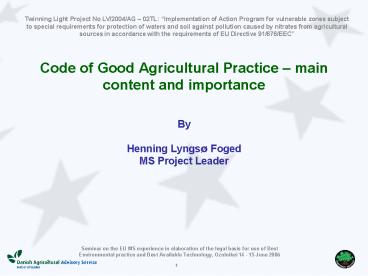Code of Good Agricultural Practice main content and importance PowerPoint PPT Presentation
1 / 16
Title: Code of Good Agricultural Practice main content and importance
1
- Code of Good Agricultural Practice main content
and importance - By
- Henning Lyngsø Foged
- MS Project Leader
2
Subjects
- Background
- Content
- Importance
3
(No Transcript)
4
Background
- Project in 1998 / 1999 undertaken by Danish
Agricultural Advisory Service in cooperation with
Latvia Agricultural University - Main financing from Danish Environmental
Protection Agency - Wish from Latvian side that the CGAP is wider
than required by the Nitrate Directive - 7 chapters Plant production, Livestock
production, Livestock manure, Plant protection,
Water resources, Agricultural production systems,
Bio-diversity and nature
5
Background
- 7 work groups with around 50 experts from 10
different institutions representing authorities,
farmers organisation, advice, research, and
education formulated the codes - this ensured
that agricultural and environmental interests
were balanced and the codes were prepared after a
participatory approach - The management involved institutions approved the
final formulations in a letter to the project - Ministries of agriculture and environment adopted
the CGAP in June 1999.
6
(No Transcript)
7
Content
- The most important part of the CGAP is the manure
standard, Table 8 page 27, and the connected
Table 13 with coefficients for Animal Units - It was defined that 1 Animal Unit the number
of animals that produce an amount of manure
equivalent to 100 kilo N ex storage. - The biggest challenge was to make Latvian experts
aware of the relation between - Fertiliser planning (Kg N, P2O5 and K2O in
livestock manure) - Manure standards (figures ex. storage)
- Livestock density (max 170 kg N or 1.7 AU per ha)
- Livestock manure storage capacity (cubic metres)
- and that livestock manure must be defined in
order to know its fertilising value
8
Temporary manure standards were defined
24 difference in N content!
9
Content
- Secondly the CGAP contains recommendations on
fertiliser planning and the procedure for that - Calculation of the needs of the crop
- Reduction with the plant nutrients in distributed
livestock manure - Fulfiling the rest of the norms with mineral
fertiliser
10
(No Transcript)
11
Content
- The CGAP recommends
- No spreading of livestock manure from 15 October
till 15 March, not on water saturated and frozen
soils (Code 27), and not on fields with slope of
more than 10? (Code 25) - Fertiliser planning (Code 23, 30 and 37), among
other on basis of soil sampling each 5 years
(Code 10) - Threshold of 10 ha
- Max 170 kg N in livestock manure per ha per year
- The CGAP defined in line with decisions in HELCOM
that the livestock manure storage capacity should
be minimum 6 months, and slurry 8 months (Code
49) - Codes 50-55 deals with the quality, design and
construction of manure stores
12
(No Transcript)
13
Content
14
Importance
- The CGAP made the basis for Cabinet Regulation
531 - Regulations on the protection of waters and
soil against pollution caused by nitrates from
agricultural sources - It is a recommendation for all farms in Latvia
15
CGAP is not a law but a recommendation for all
farms
16
For farming in respect of the aquatic
environment...

